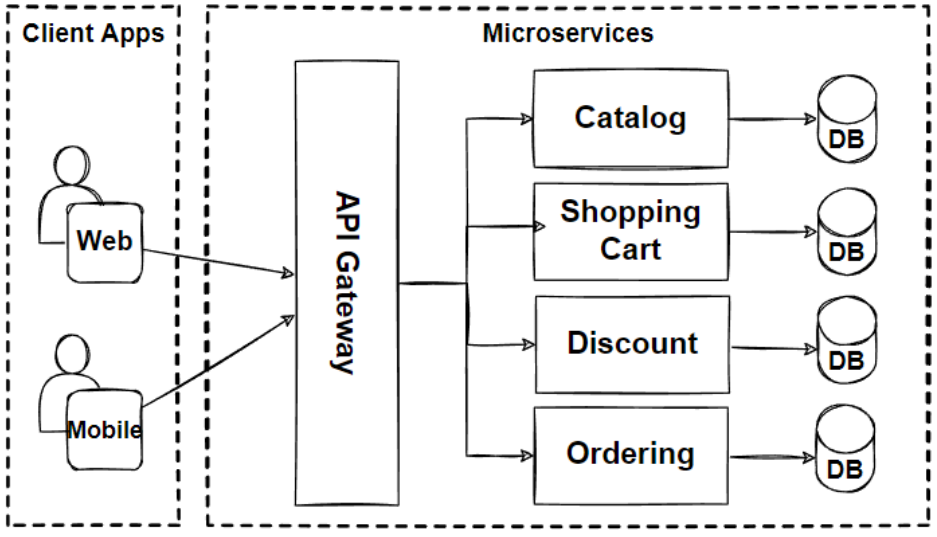The world of online shopping is evolving rapidly, with new industry trends, technological innovations, and consumer expectations emerging daily. As a competitor in the space, your eCommerce infrastructure—or, the collection of tools in processes which drive your digital customer experience—will play an increasingly important role in the success or failure of your online business.
To keep up with market trends, achieve higher business scalability, and deliver more customized user experiences, many brands—including industry leaders like Comcast, Uber, Netflix, Best Buy, and Amazon—are migrating from traditional, monolithic eCommerce platforms to a more flexible microservices approach.
Keep reading to learn more about microservices architecture and why it's a game changer for today’s online retailers.
What are microservices in eCommerce?
Microservices architecture consists of loosely coupled services and packaged business capabilities (PBCs) that together make up a single web application.

Traditional eCommerce platforms have a monolithic code base—so when an update is made for one specific service, the entire system must be modified. For growing businesses, this monolithic system produces complex development workflows and slow deployment times for new site features and functionality. This helps online merchants achieve composable commerce, a more modern approach that enables greater software development freedom and flexibility.
With a microservices approach, each service is maintained and scaled independently—so an update made to one service doesn’t create a negative ripple effect for others in the stack. Here’s a quick breakdown of each layer in a microservices architecture.
- User interface (UI) layer: The UI layer—or presentation layer—includes digital customer touchpoints like web and mobile applications. Each touchpoint—whether it be a D2C storefront, B2B sales portal, or third-party marketplace—is supported by the same set of back-end services.
- Routing layer: This layer is responsible for connecting HTTPs queries to particular microservices—which is executed via service discovery, load balancing, caching, and an API gateway.
- Container ecosystem: API calls are communicated between the routing layer and various microservices within the container ecosystem. Each eCommerce microservice acts as a database for specific business functions, such as inventory management, order fulfillment, payment processing, customer data, product information management, and so on.
While many businesses will benefit from a full-on microservices approach, others are better suited for headless commerce—a type of eCommerce architecture that falls under the umbrella of microservices and composable commerce.
What is the difference between headless commerce and microservices architecture?
Headless commerce architecture deals specifically with the decoupling of a web application’s front-end presentation layer from its back-end operations. In addition to general websites and mobile apps, common front-end eCommerce services include product catalogs, search functionality, checkout systems, chatbots, social commerce, augmented reality, and so on.
With a headless setup, front-end developers can make swift changes to the customer experience, without creating additional work for back-end developers—and vice versa. This allows online retailers to test out different UX and UI designs, implement new sales and marketing channels, and deliver personalized content to customers with more speed and efficiency than ever before.
Why migrate from monolithic to microservices architecture?
As discussed, a traditional eCommerce system cannot facilitate the same level of speed and efficiency as a microservices-based platform, due to its monolithic code base. Here are the main benefits of migrating to a microservices approach:
Faster time to market
Front-end design and development teams are able to add new features and functionalities to the customer experience—based on ever-changing market trends and consumer expectations—without requiring any changes to the back-end code. This means product pages, shopping carts, website navigation, and other presentation-layer elements can be deployed and modified instantly. Under a traditional commerce system, on the other hand, updates like these can take days, weeks, or even months to go live.
Greater eCommerce development freedom & flexibility
Microservices architecture allows you to pick and choose the best third-party integrations to support your business’ unique internal workflows and customer experience—whether that’s a specific ERP, PIM, or CMS. This is also ideal for developers because it enables them to write in any programming language they prefer, rather than exclusively in the language of their eCommerce platform.
Higher scalability
As your business grows, you’ll inevitably bring on new tools and processes—which is significantly less challenging with a microservices architecture. For instance, if you want to migrate to a more robust CMS, internationalize your eCommerce site, or implement a new payment gateway that supports cryptocurrency, you’ll be able to do so without having to execute highly-technical, time-consuming changes to the rest of your tech stack.
Adopt eCommerce microservices architecture for your business
Moving from a traditional eCommerce platform to a microservices or headless architecture can be challenging, as there are a wide range of tools and approaches to choose from. Plus, when not planned and executed effectively, migrating eCommerce data from one platform to another can result in disrupted workflows, customer experience issues, and lost data.
By partnering with Codal, you can let a team of experts guide you through the migration process. With respect to your business’ goals, technical requirements, timeline, and budget, our award-winning team will identify and implement the best tools and infrastructure for delivering a powerful, multi-channel customer experience that drives sales and conversions.
We recently launched a cutting-edge headless eCommerce solution for our client in the outdoor retail space, enabling the brand to personalize its customer journey across channels, expand to new territories, manage multiple sites under one roof, and more. You can learn more about that project here.
Ready to bring your online retail business into the next generation via microservices architecture? Get in touch with a member of our team today!







